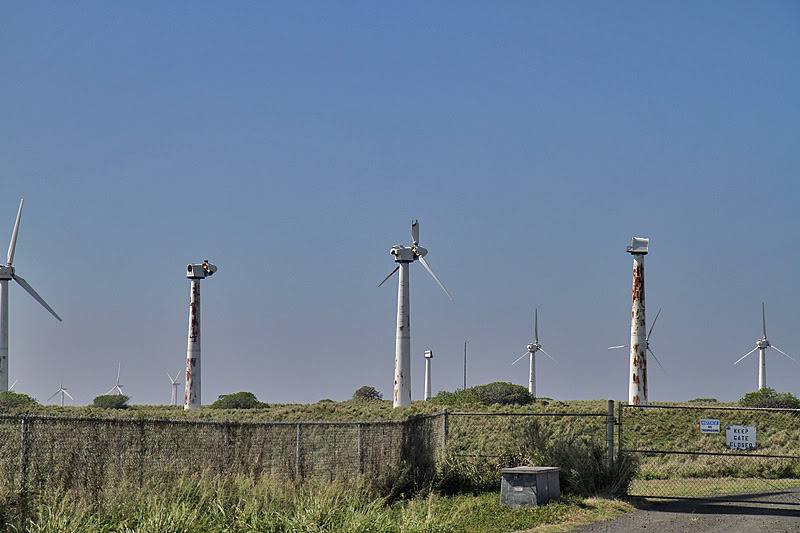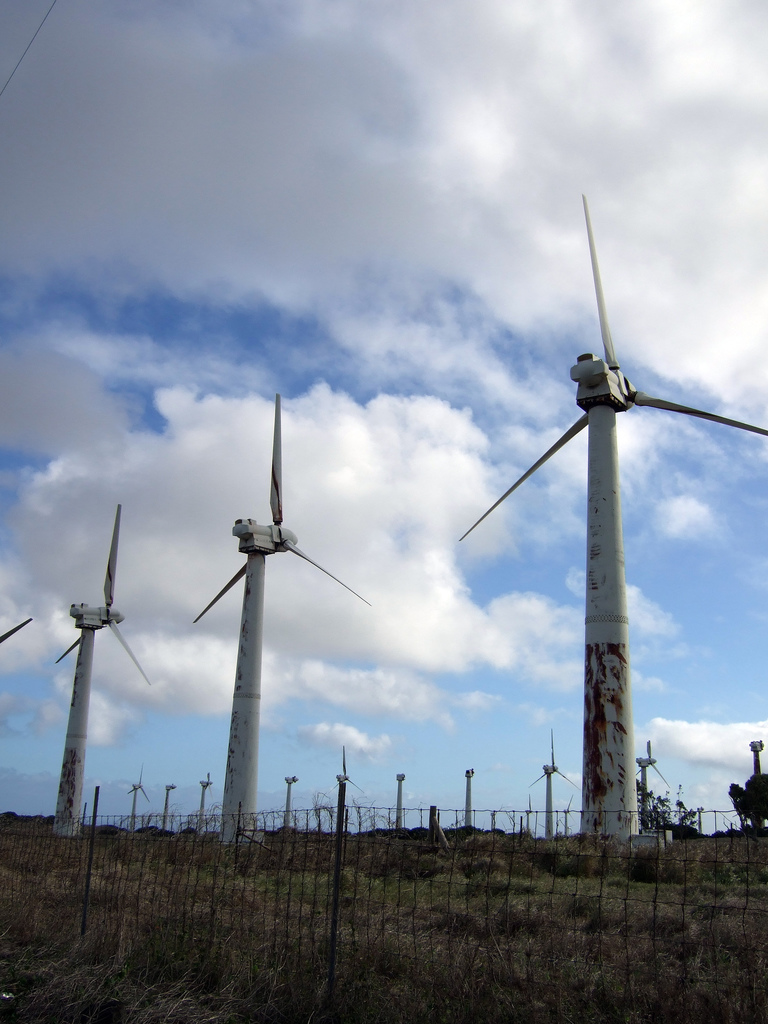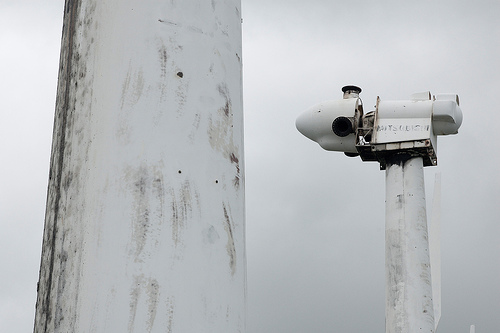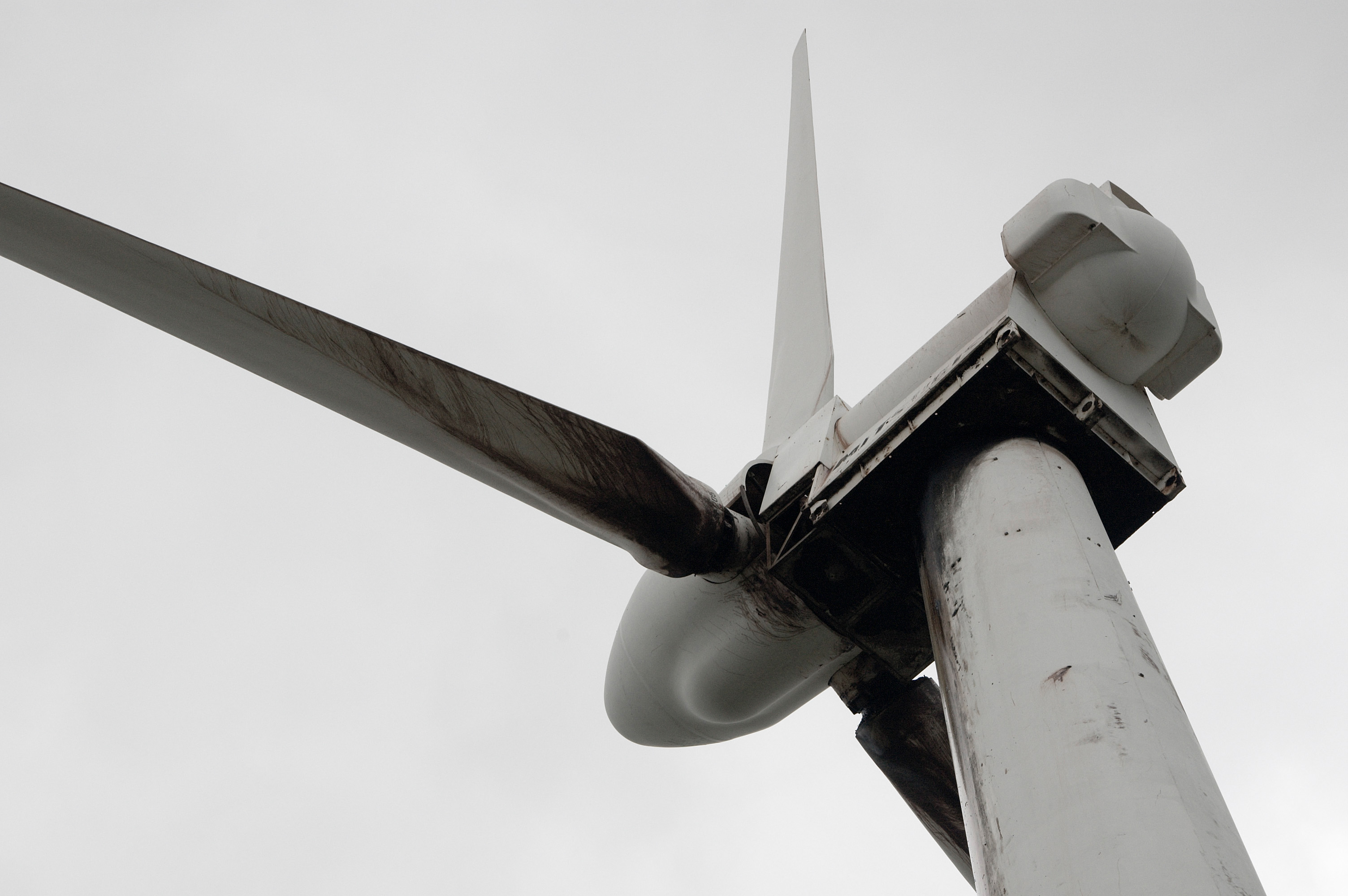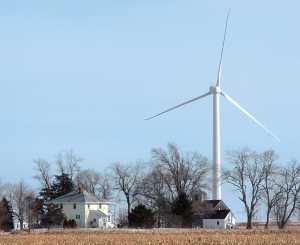It is a bright mid-September day. Hal and Judy Graham are sitting in the living room of their restored 19th century farmhouse, which looks out over the still-green rolling hills near Cohocton, a rural community in the Finger Lakes region of upstate New York.
The pastoral view is punctuated by two 420-foot-high structures. The sleek towers, almost alien in appearance, are wind turbines. One of them stands 1,000 feet from the farmhouse, on a neighbor's property. The second is 2,000 feet away on the Grahams' own land.
On this afternoon in the late summer of 2009, the twin Goliaths are still. One was shut down last winter after a flurry of attempted repairs, and the other has unaccountably been shut down for just a couple of days. But the Grahams expect it to be only a temporary respite. When the winds are high and the turbines are spinning fast, "it sounds like a jet engine taking off in your backyard," says Judy Graham. "Only it never stops."
In 2004, the Grahams signed a contract that permitted a company named UPC Wind (since renamed First Wind) to construct and operate a wind turbine on their property as part of a 50-turbine "farm" that stretches across a number of properties. Later, the town of Cohocton passed an ordinance that effectively exempts leaseholders from any noise controls.
"They told us that the noise at 900 feet would be no louder than the hum of a refrigerator," says Hal Graham. But he says the reality has been far different. "We can't sleep. We can't watch TV. This has been a disaster for us and our neighbors."
Wind power is one of the current darlings of the movement to find alternative energy sources, and in 2008 the United States surpassed Germany as the world's leading producer of electricity generated by wind. "With the right government policies, this cost-effective source of energy could provide at least 20 percent of the nation's electricity by 2030, create thousands of jobs, and revitalize farms and rural communities-without consuming any natural resource or emitting any pollution or greenhouse gases," says the American Wind Energy Association on its website.
But an increasingly vocal minority says there is another, more sinister, side to wind power. They acknowledge that, from a distance, the towering sentinels seem to spin lightly and noiselessly in the wind. But closer up, they insist, turbines emit stomach-jarring whooshes and rumbles, and an impossible-to-ignore rhythmic hum that disrupts sleep and causes headaches, nausea and fatigue in some people.
Another problem is shadow flicker, caused when the spinning blades chop up sunlight, creating a swooping pattern of shadows that some people say makes them woozy and sick.
Dr. Nina Pierpont, a pediatrician in Malone, N.Y., at the north edge of Adirondack Park, has coined the phrase wind turbine syndrome to describe the cluster of symptoms-sleeplessness, headaches, depression, dizziness and nausea-that she has identified in people she has studied who live within a mile of industrial-size wind turbines. In November, Pierpont published a report on some of her research, Wind Turbine Syndrome: A Report on a Natural Experiment. Pierpont's findings have been criticized by some in the wind energy industry, partly on grounds that her study looked at fewer than 40 people.
• • •
The growing contentiousness over the health effects of wind turbines already has resulted in some sharp legal fights -with more sure to come-over where turbines should be located and how they should be regulated. And because wind power can be harnessed most efficiently in wide-open spaces-the largest wind farms contain hundreds of turbines-the task of sorting out these issues has fallen primarily on local government bodies representing communities such as Cohocton.
According to a U.S. Chamber of Commerce webpage titled "Project No Project," which tracks energy projects that have been stalled or killed, more than 70 wind farm proposals around the country are bogged down by moratoriums, restrictive ordinances, environmental challenges and lawsuits filed by community groups.
Although the states and even the federal government are inexorably being drawn into the issue, for now it is local government taking the lead to craft ordinances and zoning regulations that try to answer questions like these: When it comes to placing wind turbines near residences, how close is too close? And how loud is too loud?
Under the 10th Amendment to the U.S. Constitution, land use generally is regulated at the local level through the police power of towns, cities and counties to protect the health, safety and general welfare of their residents, says Glenn M. Stoddard, an attorney in Eau Claire, Wis., who has helped local governments in his state develop wind ordinances.
Generally, a local government can't just ban an industry outright, Stoddard says. "There's a zoning doctrine that basically prohibits what we call ‘exclusionary zoning' in which a local government simply discriminates against a certain type of land use," he says. There must be a rational reason for restricting an industry that is related to the health, safety or general welfare of the populace.
This is a tricky standard when it comes to regulating noise. "There's plenty of evidence that noise makes people sick," says Arline L. Bronzaft, a New York City psychologist who has conducted landmark research linking classroom noise to learning deficits in children. According to the World Health Organization, noise can interfere with sleep, speech, learning and social behavior, as well as cause stress, cardiovascular problems and, at high decibel levels, impaired hearing.
But there are no national standards defining just how much noise is too much. The U.S. Noise Pollution and Abatement Act of 1972 promised to "promote an environment for all Americans free from noise that jeopardizes their health or welfare." But the Office of Noise Abatement and Control created to enforce the law has been defunded since the Reagan administration.
The EPA's website contains guidelines on acceptable noise levels based on the agency's 1974 Information on Levels of Environmental Noise Requisite to Protect Public Health and Welfare with an Adequate Margin of Safety-commonly known as the Noise Levels Document. But Les Blomberg, executive director of the Noise Pollution Clearinghouse in Montpelier, Vt., says these guidelines were developed with the residents of noisy urban environments in mind. Too often, he says, the guidelines are applied without making the adjustments suggested by the Noise Levels Document for quieter rural areas or for noise with characteristics that make it particularly troublesome.
• • •
On Sept. 19, the town board of Italy-a tiny hamlet about 15 miles northeast of Cohocton-met to hear comments on a proposal by Ecogen Wind of West Seneca, N.Y., to erect 18 wind turbines on the surrounding hills.
Many opponents of the proposal wore black T-shirts emblazoned with "50 dBA No Way."
The slogan refers to daytime noise limits measured at property lines near wind turbines. A limit of 50 decibels on the A-weighted scale-the most common measure for sounds perceived by the human ear-is the standard set by most local wind ordinances. Most also require a minimum setback from residences of 1,000 feet.
That would seem to be in line with EPA guidance, which suggests an outdoor noise limit of 55 dBA, though the Noise Levels Document also suggests that, in quiet rural areas, 10 dBA be subtracted from this level.
Some argue that wind turbine noise may be a problem even at this level. "It appears that the noise that comes from wind farms bothers people at lower decibel levels than aircraft noise and road noise," says Jim Cummings, executive director of the Acoustic Ecology Institute in Santa Fe, N.M.
For one thing, the whirling of the blades causes a rhythmic pulsing that Bronzaft likens to "the drip, drip, drip of the faucet that makes you crazy, crazy, crazy." Noise that pulses should be adjusted down by 5 dBA, suggests the EPA's Noise Levels Document.
Then there's low-frequency noise-sound that vibrates relatively slowly and is pitched low on the scale of sounds audible to the human ear. It travels farther and penetrates walls and windows more efficiently than high-frequency noise, making it hard to block out. Think of the pulsing sound you hear when a car blasting its stereo pulls up next to you at the stoplight-that's low-frequency sound, stripped of its higher frequency components by the closed car windows.
According to the World Health Organization, low-frequency sound can accentuate the negative health impacts of noise, and even sounds below 30 dBA can disturb sleep.
The American Wind Energy Association and other wind power advocates generally dismiss claims of conditions like wind turbine syndrome. In December, the association and its Canadian counterpart issued a report concluding that, while some people may be "annoyed" by wind turbine noise, there is no reason to believe such noise creates health risks.
Some wind advocates suggest that, in certain cases, claims of health concerns may be a smokescreen for another reason why some people oppose wind turbines: They don't like the way they look.
"My impression is that a lot of the opponents are people who want to stop the turbine coming into their backyards, and not because they think that it will cause this or that health problem," says Patricia E. Salkin, director of the Government Law Center at Union University's Albany Law School. She also is a past chair of the ABA Section of State and Local Government Law.
A study conducted in the Netherlands, for instance, found that people disturbed by the look of wind turbines were more likely to be bothered by the noise, as well.
"What's clear is that there are people making claims" about the health impact of wind turbines, says Jeff Deyette, a senior energy analyst for the Union of Concerned Scientists, a strong advocate of wind power headquartered in Cambridge, Mass. "But there are really not a whole lot of, or hardly any, epidemiological studies to bear them out."
Trey Cox, an attorney at Lynn Tillotson Pinker and Cox in Dallas, represented a wind farm developer in what he says is the first nuisance claim based on noise impacts to be heard by a jury.
The plaintiffs lived in the vicinity of the Horse Hollow Wind Farm near Abilene, Texas. With 421 turbines spread out over 47,000 acres, Horse Hollow, owned by FPL Energy, is the world's second-largest wind farm. The nearby property owners sought injunctive relief based on claims of nuisance. At trial, defense sound experts testified that, after logging 675 hours of sound measurements at plaintiffs' residences, they found that wind turbine noise averaged 28 dBA at a distance of 1.7 miles from the wind turbines, and 44 dBA at 1,700 feet. In an 11-1 verdict, the jury found that these noise levels did not constitute a nuisance.
At trial, Cox was struck by the testimony of a plaintiff he described as "a wonderful woman, a salt-of-the-earth type," who testified that the sound of the wind turbine on her land was equivalent to the sound of a B-1 bomber.
"Well, I knew that was impossible," says Cox. "A B-1 bomber makes a sound around 101 decibels. I think that when people don't like the wind turbine, they become bigger, they become louder and they become uglier in their minds."
On appeal to the Texas Court of Appeals in Rankin v. FPL Energy, the nearby property owners argued that the trial court erred when it instructed the jury not to consider aesthetics in deciding whether the wind farm was a nuisance to those on nearby properties. The appellate court upheld the trial court, however, on grounds that aesthetics are not a basis for nuisance claims under Texas law.
Cummings says the argument that opposition to wind turbines is primarily a matter of what they look like "drives me crazy." He acknowledges, however, that there is a strong psychological component to noise perception, as well as a wide variation in individuals' responses to sound. The same low-frequency pulsing sound that drives one person up a wall can be imperceptible to another, and to a third it is soothing background noise.
"But one of the questions is: How much of the population living around a wind farm is it OK to disturb?" Cummings says. "If 20 percent of the residents are bothered, is that OK?"
• • •
It is clear from the prevalence of pro-wind posters displayed in yards and windows in Cohocton that the wind farm enjoys strong support from many residents. In 2007, town supervisor Jack Zigenfus defeated anti-wind activist Judy Hall by a vote of 506-210, according to local press reports. By 2008, Zigenfus was boasting about a 30 percent reduction in local taxes because of cash incentives First Wind paid to the town.
In neighboring Italy, however, opposition to its proposed wind farm has been fueled by the complaints of people living or working within earshot of the Cohocton wind turbines. At the town board meeting in September, a Cohocton man asked Italy to reject a wind project proposed by Ecogen Wind because "I may need someplace with peace and quiet to move to."
Others, though, urged the board to approve the project, some because they hoped for lower taxes and some because they feared that the developer would sue if the town didn't go along with the plan.
"They've got a lot more money than we'll ever have," said one speaker. Another said, "You have to choose your battles, and I think this battle here, we're going to lose if we fight it."
John Servo, a resident of neighboring Prattsburgh, scoffed at giving in. "If people in 1776 had that attitude, we'd still be part of the British empire," said Servo, who belongs to Advocates for Prattsburgh, which opposes a proposed wind farm outside of that community.
But the fear of being sued is real. In 2006, after Italy repeatedly extended a six-month moratorium that was first imposed in 2004, Ecogen sued the town in federal court. Ecogen argued that the moratorium was facially unconstitutional because it denied the company the use of property without due process.
Judge David G. Larimer of the U.S. District Court for the Western District of New York in Rochester rejected Ecogen's argument, however, ruling the moratorium, though "suspicious" in its length, could serve a legitimate public purpose. Still, the town had to pay fees and costs of $80,000 when Larimer rejected its claim that they be paid by Ecogen.
And as the issue heated up again during 2009, the town board sent a letter to residents in July expressing fears that if the town didn't eventually accept Ecogen's proposal, "because of wind resources in the town of Italy and the push for renewable energy, industrial wind turbines will eventually be forced on the town by either the state or federal government."
Several states, including Ohio, Washington and Wisconsin, have passed laws restricting local control over wind turbine projects.
A 1982 Wisconsin statute, for instance, allowed local governments to regulate solar power projects only when the health and safety of residents were specifically involved.
Local regulation was prohibited as a matter of the general welfare. The state legislature amended the statute in 1993 to extend the same restrictions on local government bodies regarding wind energy projects.
Still, some local governments, basing their actions on health and safety concerns alone, have passed ordinances blocking or limiting wind energy projects that developers say are equivalent to imposing a ban on the industry. Stoddard helped draft an ordinance adopted by the town of Wilton, about 75 miles northwest of Madison, establishing setbacks of 2,640 feet from residences and noise limits of 40 dBA or 40 dBC (decibels measured on the C-weighted scale, a better assessment of low-frequency noise) within 100 feet of any residence, and no more than 5 dBA or dBC over ambient noise levels.
On Oct. 2, Wisconsin Gov. Jim Doyle signed Senate Bill 185 into law, directing the state's Public Service Commission to develop standards for siting wind power facilities-including noise levels and setbacks-that local governments will not be permitted to exceed.
"What it really boils down to is a kind of classic legal battle over rights," says Stoddard. "If someone has enough clout, they can override someone else's rights."
A law like Wisconsin Senate Bill 185 would be a tough sell in New York, which has a strong tradition of home rule, says Clifford C. Rohde, an associate at Cooper Erving & Savage in Albany who maintains the Wind Power Law Blog.
Nevertheless, there have been calls for the New York legislature to revive Article X of the New York Public Service Law, which took siting decisions for power facilities out of the hands of local governments. The law expired in 2003.
Salkin says the federal government should step in, as it did with regard to cellular communication towers, which had also faced tough local opposition due to concerns about possible health effects caused by the radio frequency radiation emitted by the towers. The Telecommunications Act of 1996 barred local governments from considering the environmental impact of radio frequency radiation emissions when regulating the placement of cell towers.
Fearing the possibility that federal or state government might force wind farms on them, some local government bodies are seeking to strike the best deals they can get with developers while they still hold some of the cards, says Arthur Giacalone, an attorney in East Aurora, N.Y., near Buffalo, who represents homeowners in disputes relating to wind power.
A town board may, for instance, offer a wind farm a special-use permit instead of requiring the developer to obtain a rezoning. "Once a project has been given a special-use permit, the developer can do pretty much what it wants to do," Giacalone says.
In some cases, towns skimp on, or even bypass, the environmental review mandated by New York's State Environmental Quality Review Act. The review is supposed to take into account the impact of the project on noise, human health, aesthetic resources and community or neighborhood character.
Giacalone represented a group of residents in a successful bid to overturn a wind ordinance that had been adopted by the town of Hamlin, west of Rochester, on this basis. Upholding the challenge in HPG v. Hamlin Town Board, Justice David Michael Barry of the trial-level New York Supreme Court ruled on Jan. 5, 2009, that the town had failed to take the requisite "hard look" at the environmental impact of wind energy development.
Some members of town boards might have their own reasons not to take a hard look at wind farm proposals. Typically, developers interested in setting up a wind farm first negotiate contracts with local landowners that offer annual payments of $3,000 or more to construct and operate one or more wind turbines on their properties. Then they take their plans to the town board for approval.
But in small agricultural communities, members of the town board often are major landowners as well, says Rohde. By the time the wind project developer approaches the town government, board members or their relatives might have financial stakes in the project. In July 2008 the New York attorney general's office launched an investigation into alleged improper dealings between wind farm developers and local officials, leading to a voluntary code of conduct by which 16 companies, accounting for 90 percent of wind energy development in the state, have agreed to abide.
• • •
The sense that they were up against a combination of moneyed interests, as well as federal and state policies, left some opponents of the Italy project discouraged. At the town board meeting in September, 119 people spoke in opposition to the project while 20 expressed support, according to a tally kept by an anti-wind group. Still, one opponent said, "I don't know if anybody is listening."
But on Oct. 5, the Italy town board surprised both opponents and supporters of the project. Despite being offered a package of amenities-including a one-time cash payment of $1.6 million for a new town hall addition, a salt barn and a new all-wheel-drive truck, as well as additional cash payments estimated at $300,000 to $400,000 per year-the board voted to deny Ecogen's application.
Dallas attorney Cox says wind project developers would much prefer that such decisions be made higher up the governmental ladder-at least at the state level. "The problem from the energy generators' point of view," he says, "is that when you consider how much they invest in a project, it's a pretty scary thing to turn it over to 12 people to decide if this billion-dollar project is going to be taken down."
But Cox also says the industry should be flexible about responding to concerns. One approach would be to extend setbacks to keep wind turbines farther away from residences. "I don't think that turbines are a nuisance by sound or by sight even if you put them 300 or 500 feet from residences," says Cox, "but if you put them farther away it'll go a long way toward alleviating people's complaints."
In a move that sent shock waves throughout the industry, the minister of energy for the Canadian province of Ontario in September proposed setbacks of about 1,800 feet from any residence, and at least 3,000 feet for wind turbines producing more than 106 dBA of noise at their bases. The Canadian Wind Energy Association estimated that these guidelines would eliminate or require extensive redesign of 79 of the province's 103 "shovel ready" wind projects.
Others question the value of mandatory setbacks. They may be an oversimplistic solution that would unnecessarily limit the number of sites that can be developed as wind farms, says Dwight H. Merriam, a partner at Robinson & Cole in Hartford, Conn., who is chair-elect of the ABA Section of State and Local Government Law (and the section's liaison to the ABA Journal). At the very least, he says, setbacks should be rebuttable, allowing developers to go to court and argue that they can be modified in some cases.
Deyette at the Union of Concerned Scientists says regulators should not leap to the assumption that setbacks always will be the answer to complaints about wind turbines. In many cases, he says, the solution may be mitigation measures such as strategically planted trees that muffle low-frequency sound and block shadow flicker.
"Wind is a viable and necessary part of our climate change mitigation strategy," Deyette says. "And it's available today, so we should be wrapping it up as quickly as possible. That being said, if it's not being done appropriately, we're going to be experiencing increased pushback."
Cummings of the Acoustic Ecology Institute agrees that the wind energy industry must take opposition into account. "My concern is that if the industry is too aggressive about siting wind farms, it's going to make the next round of wind farm development more problematic," he says. "The Internet is already full of people talking about how horrible the wind farms are."
What's the connection between night time noise and coronary heart disease? What do wind turbines have to do with any of this?
Source: Pub Med/Environmental Health Perspectives: Monthly Journal of Peer-Reviewed Research and News on the Impact of the Environment on Human Health
According to the results of a peer-reviewed study made available by the National Institutes of Health, the connection between noise and coronary heart disease -particularly at night- is serious.
This article by M. Nathaniel Mead helps us understand why the 50 dbA noise limit for wind farms in Wisconsin is not enough protection.
NOISE POLLUTION: THE SOUND BEHIND HEART EFFECTS
More than 15 million Americans currently have some form of coronary heart disease (CHD), which involves a narrowing of the small blood vessels that supply blood and oxygen to the heart. Risk factors for CHD include diabetes, high blood pressure, altered blood lipids, obesity, smoking, menopause, and inactivity. To this list we can now add noise, thanks to a recent study and assessment of the evidence by the WHO Noise Environmental Burden on Disease working group. The findings, first presented at the Internoise 2007 conference in August 2007, will be published in December.
“The new data indicate that noise pollution is causing more deaths from heart disease than was previously thought,” says working group member Deepak Prasher, a professor of audiology at University College in London—perhaps hundreds of thousands around the world. “Until now, the burden of disease related to the general population’s exposure to environmental noise has rarely been estimated in nonoccupational settings at the international level.”
The separate noise-related working group first convened in 2003 and began sifting through data from studies in European countries to derive preliminary estimates of the impact of noise on the entire population of Europe. They then sought to separate the noise-related health effects from those of traffic-related air pollution and other confounding factors such as physical inactivity and smoking. In 2007, the group published Quantifying Burden of Disease from Environmental Noise, their preliminary findings on the health-related effects of noise for Europeans. Their conclusion: about 2% of Europeans suffer severely disturbed sleep, and 15% suffer severe annoyance due to environmental noise, defined as community noise emitted from sources such as road traffic, trains, and aircraft.
According to the new figures, long-term exposure to traffic noise may account for approximately 3% of CHD deaths (or about 210,000 deaths) in Europe each year. To obtain the new estimates, the working group compared households with abnormally high noise exposure with those with quieter homes. They also reviewed epidemiologic data on heart disease and hypertension, and then integrated these data into maps showing European cities with different levels of environmental noise.
The noise threshold for cardiovascular problems was determined to be a chronic nighttime exposure of at least 50 A-weighted decibels, the noise level of light traffic. Daytime noise exposures also correlated with health problems, but the risk tended to increase during the nighttime hours. “Many people become habituated to noise over time,” says Prasher. “The biological effects are imperceptible, so that even as you become accustomed to the noise, adverse physiological changes are nevertheless taking place, with potentially serious consequences to human health.”
To further assess the noise-related disease burden, the working group estimated disability-adjusted life years (DALYs) due to noise-related CHD. DALYs reflect how much the expectancy of healthy life is reduced by premature death or by disability caused by disease. This measure lets policy makers compare disease burdens associated with different environmental factors and forecast the likely impact of preventive policies. The working group estimated that in 2002 Europeans lost 880,000 DALYs to CHD related to road traffic noise.
Chronic high levels of stress hormones such as cortisol, adrenaline, and noradrenaline can lead to hypertension, stroke, heart failure, and immune problems. According to a review of the research in the January–March 2004 issue of Noise and Health, arousal associated with nighttime noise exposure increased blood and saliva concentrations of these hormones even during sleep. “Taken together, recent epidemiologic data show us that noise is a major stressor that can influence health through the endocrine, immune, and cardiovascular systems,” says Prasher.
Other recent support for an association of cardiovascular mortality with noise comes from a study published in the 1 January 2007 issue of Science of the Total Environment. The results showed an 80% increased risk of cardiovascular mortality for women who judged themselves to be sensitive to noise. “Given these findings, noise sensitivity is a serious candidate to be a novel risk factor for cardiovascular mortality in women,” says Marja Heinonen-Guzejev, a research scientist at the University of Helsinki and lead author of the paper.
There is also a potential interaction between noise and air pollution, given that individuals exposed to traffic noise, for example, are often simultaneously exposed to air pollution. Prasher is currently investigating the effects of noise alone and in combination with chemical pollution.
The broader implications of chronic noise exposure also need to be considered. “Noise pollution contributes not only to cardiovascular disease, but also to hearing loss, sleep disruption, social handicaps, diminished productivity, impaired teaching and learning, absenteeism, increased drug use, and accidents,” says physician Louis Hagler, who coauthored a review on noise pollution in the March 2007 Southern Medical Journal. “The public health repercussions of increasing noise pollution for future generations could be immense.”
Written by M. Nathaniel Mead Environ Health Perspect. 2007 November; 115(11): A536–A537.
Copyright This is an Open Access article: verbatim copying and redistribution of this article are permitted in all media for any purpose.
Noise Pollution: The Sound Behind Heart Effects
M. Nathaniel Mead
